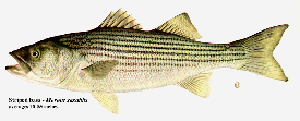Why do scientists classify fish?
Since common or colloquial names of fish vary from place to place (menhaden, for example, are known by at least three different names, and striped bass are called "stripers" in New England and "rockfish" in Chesapeake Bay),investigators would have no way of differentiating among species without a uniform naming system. The system used to name the 20,000 odd fishes known to science is called "the binomial system of nomenclature." It usually consists of a scientific name in two parts, the generic and specific names, or three parts if subspecies have been described.
The generic name generally applies to several species showing basic characteristics while a specific (species) name is based on a few characteristics applying to one species, separate and distinct from all others. (Example: The generic name Morone applies to white perch, white bass, and striped bass; the species names for those three fishes are Morone americanus, M. chrysops, and M. saxatilis.)
The words of the names are latinized regardless of the language or alphabet of the study and are frequently descriptive of a significant feature of the organism.

 Deep Sea Crabs
Deep Sea Crabs